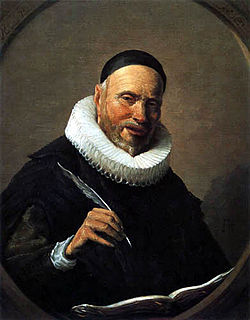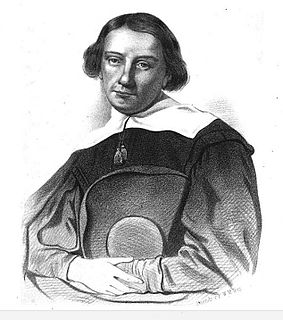
The Dutch West India Company was a chartered company of Dutch merchants as well as foreign investors. Among its founders was Willem Usselincx (1567–1647) and Jessé de Forest (1576–1624). On 3 June 1621, it was granted a charter for a trade monopoly in the Dutch West Indies by the Republic of the Seven United Netherlands and given jurisdiction over Dutch participation in the Atlantic slave trade, Brazil, the Caribbean, and North America.

Emanuel van Meteren or Meteeren was a Flemish historian and Consul for "the Traders of the Low Countries" in London. He was born in Antwerp, the son of Sir Jacobus van Meteren, Dutch financier and publisher of early English versions of the Bible, and Ottilia Ortellius, of the famous Ortellius family of mapmakers, and nephew of the cartographer Abraham Ortelius.

Willem Cornelisz Schouten was a Dutch navigator for the Dutch East India Company. He was the first to sail the Cape Horn route to the Pacific Ocean.
Willem Janszoon, sometimes abbreviated to Willem Jansz., was a Dutch navigator and colonial governor. Janszoon served in the Dutch East Indies in the periods 1603–1611 and 1612–1616, including as governor of Fort Henricus on the island of Solor. During his voyage of 1605–1606, he became the first European known to have seen the coast of Australia.
Joannes or Johannes De Laet was a Dutch geographer and director of the Dutch West India Company. Philip Burden called his History of the New World, "...arguably the finest description of the Americas published in the seventeenth century" and "...one of the foundation maps of Canada". De Laet was the first to print maps with the names Manhattan, New Amsterdam and Massachusetts.
J.C.M. Warnsinck was a Dutch naval officer and naval historian.

Jan Lievens was a Dutch Golden Age painter who was associated with his close contemporary Rembrandt, a year older, in the early parts of their careers. They shared a birthplace in Leiden, training with Pieter Lastman in Amsterdam, where they shared a studio for about five years until 1631. Like Rembrandt he painted both portraits and history paintings, but unlike him Lievens' career took him away from Amsterdam to London, Antwerp, The Hague and Berlin.

Olfert Dapper was a Dutch physician and writer. He wrote books about world history and geography, although he never travelled outside the Netherlands.

Hessel Gerritsz was a Dutch engraver, cartographer, and publisher. He was one of the notable figures in the Golden Age of Netherlandish cartography. Despite strong competition, he is considered by some "unquestionably the chief Dutch cartographer of the 17th century".

Pieter van den Broecke was a Dutch cloth merchant in the service of the Dutch East India Company (VOC), and one of the first Dutchmen to taste coffee. He also went to Angola three times. He was one of the first Europeans to describe societies in West and Central Africa and in detail trade strategies along the African coast.

Gerrit Mannoury was a Dutch philosopher and mathematician, professor at the University of Amsterdam and communist, known as the central figure in the signific circle, a Dutch counterpart of the Vienna circle.

Pieter Bor, or Pieter Christiaensz Bor (1559-1635) was a Dutch Golden Age writer and historian. His portrait was painted by Frans Hals in 1634, and it was engraved for his book in 1637.
Barent Eriksz was a Dutch trader from Medemblik, who is considered the initiator of Dutch trade with the Gold Coast in Africa.
Hendrik Severinus Pel was a Dutch zoologist and colonial administrator on the Dutch Gold Coast.
Johannes Petrus Hoogenboom was a colonial administrator on the Gold Coast, who served as acting governor-general of the Dutch Gold Coast between 21 July 1807 and his death on 4 August 1808.

Passchier de Fijne was a Netherlands pastor and writer. He was one of the first pastors of the Remonstrant Brotherhood. Because of his forbidden preaching on the ice of the river Gouwe at Gouda he was also called "the kingfisher".
Jan Frederik König was a colonial administrator on the Gold Coast, who served as acting commander of the Dutch Gold Coast between 4 August 1808 and 23 February 1810.

This article covers the science, art and industry of cartography by the people of the Low Countries in the early modern period, especially in the early 16th to early 18th centuries. It includes cartography of the Northern Netherlands, Southern Netherlands and Low Countries in general. It also includes Dutch colonial cartography, i.e. cartography in the Dutch overseas world, in the early modern period.

Jan Pietersz Graeff was an Amsterdam regent and cloth merchant from the 16th century.












